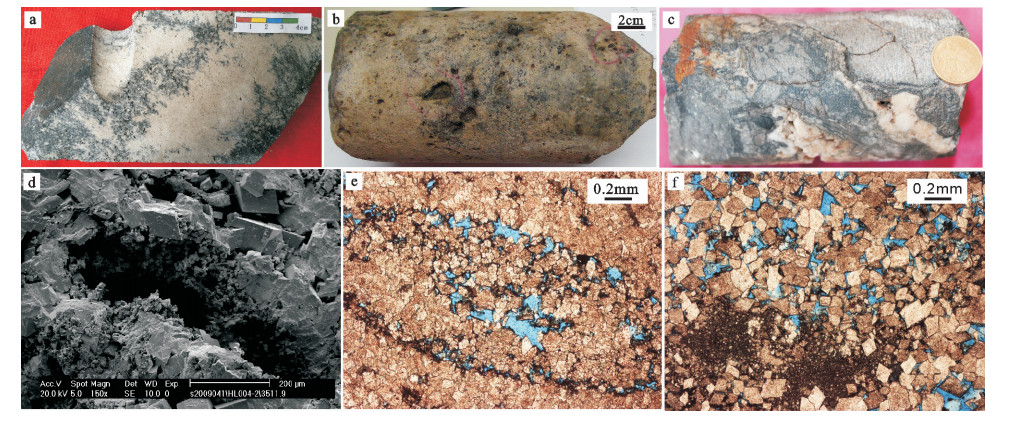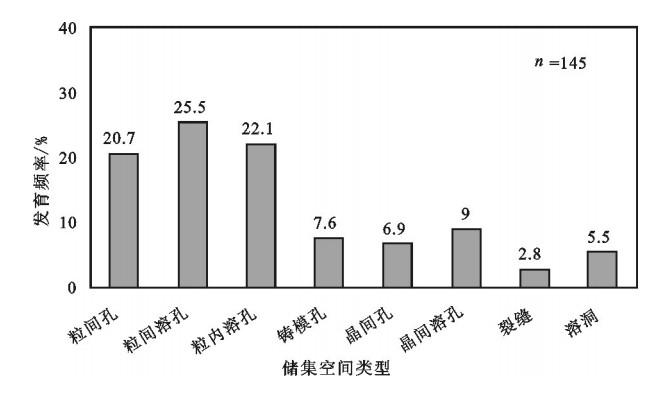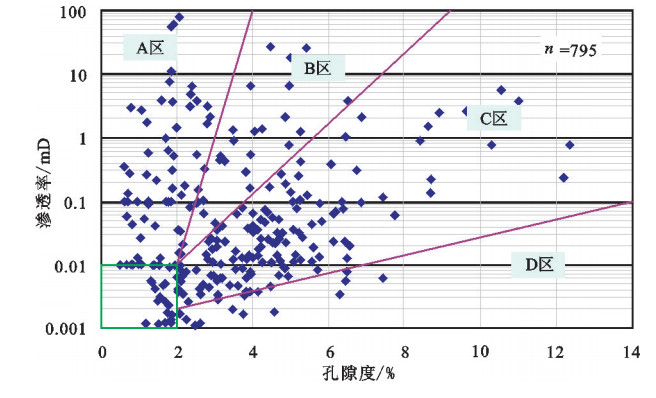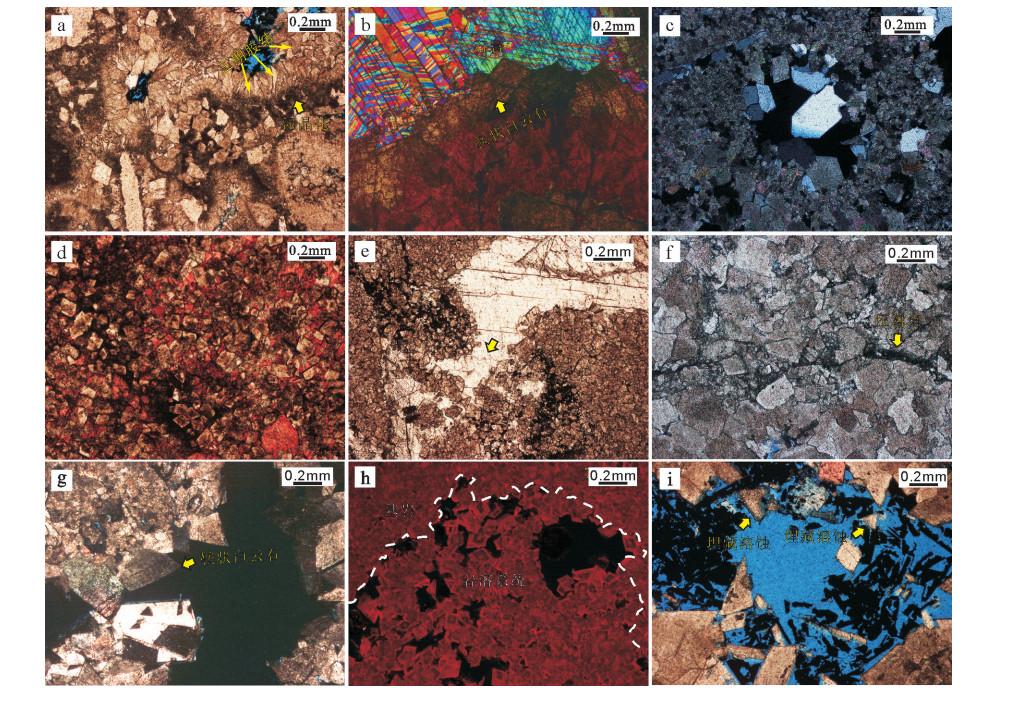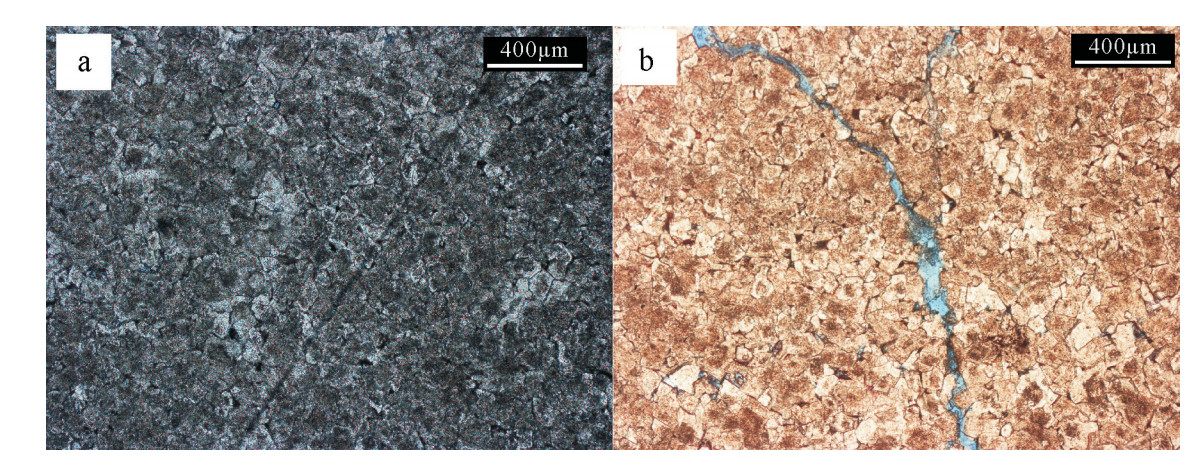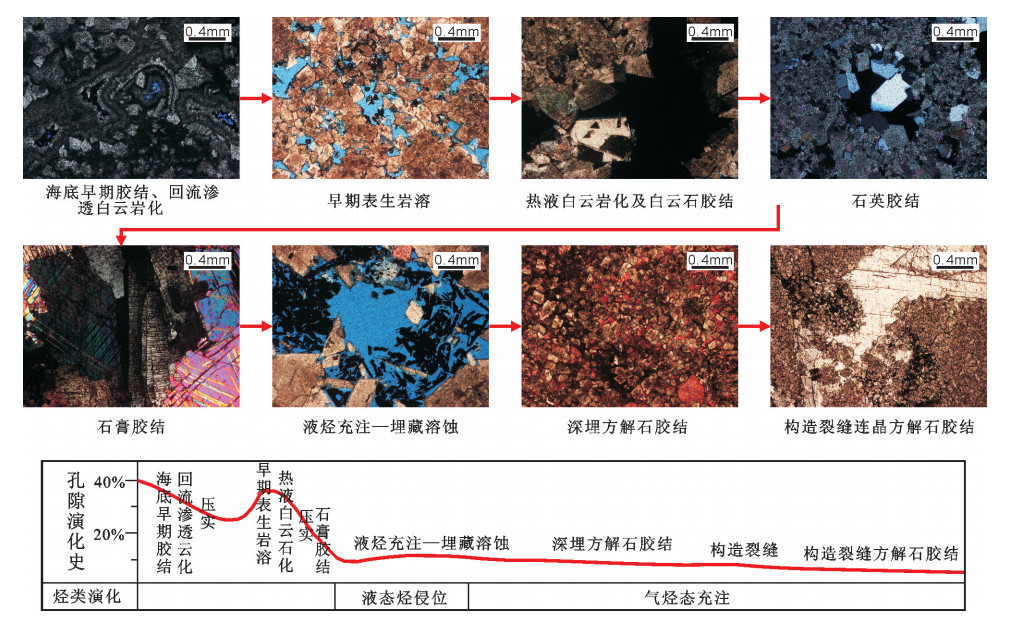Characteristics and diagenesis of platform margin reef-shoal reservoirs of Upper Permian Changxing Formation around Kaijiang-Liangping Trough, eastern Sichuan Basin
-
摘要:
通过岩心观察、薄片鉴定、电镜扫描、阴极发光、物性分析,对四川盆地东部环开江-梁平海槽上二叠统长兴组礁滩相储层特征、储层成岩作用进行研究,并初步建立成岩演化序列。储层特征研究发现,长兴组储层发育良好,储集岩以“花斑状”生屑云岩和生物礁云岩为主,粒间孔、粒间溶孔和粒内溶孔较为发育,孔隙度总体介于2%~6%,渗透率集中在0.1~1 mD,结合孔渗相关关系将其划分为4种储层类型:“低孔高渗”型、“中孔中渗”型、过渡型、“高孔低渗”型。储层成岩作用研究发现,储层在成岩阶段经历了多期胶结、压实、白云岩化、溶蚀、构造破裂等成岩作用。由于成岩作用对孔隙结构的改造,孔隙演化整体上呈减小趋势。胶结作用及压实作用使得原生孔隙大幅度减少,对储层的形成具有破坏性作用,溶蚀及白云岩化作用对储层的形成具有建设性作用,构造破裂对储层进一步优化改造。研究表明原生粒间孔和早成岩期岩溶及热液白云岩化作用形成的早期次生孔隙不仅是现今储层储集空间的雏形,也基本决定了储层的最终面貌。
Abstract:In this paper, the authors utilized cores and thin sections observations, SEM, cathodoluminescence and physical property analysis to study characteristics and diagenesis of the reservoir within Upper Permian Changxing Formation, and preliminarily established diagenetic evolution sequence. The interval is mainly featured by platform margin reef-shoal around KaijiangLiangping trough in eastern Sichuan Basin. Reservoir characteristics reveal that the Changxing reservoirs are developed well. Reservoir rocks are composed of"piebald"bioclastic dolomite and reef dolomite dominate, whereas reservoir spaces mainly comprise intergranular pores, dissolved intergranular pores and dissolved intragranular pores. The reservoir porosity is mainly between 2% and 6%, and the permeability is between 0.1 mD and 1 mD. Four types of reservoirs were found, i.e., "low-porosity and high-permeability" type, "medium-porosity and medium-permeability" type, transitional type and "high-porosity and lowpermeability" type. The diagenetic evolution indicates that Changxing Formation experienced cementation, compaction, dolomitization, dissolution and tectonic fracturing. A decreasing trend in porosity due to the superimposed modification by multiplephase diagenesis was observed. Cementation and compaction occupied most of primary pores and reduced the porosity after the deposition. Karstification and dolomitization improved the porosity by transforming the textures of pores. Tectonic fractures further optimized the reservoir. Research shows that primary intergranular pores and eogenetic secondary pores formed by eogenetic karstification and hydrothermal dolomitization not only serve as the prototype of reservoir space but also generally determine the final appearance of the reservoir.
-
1. 引言
四川盆地东部长兴组礁滩相储层为重要的天然气勘探目的层,且主要分布于开江-梁平海槽的东西两侧[1-5]。碳酸盐沉积后作用与储层储集性能的关系十分密切,碳酸盐岩孔隙的形成、增大、减少甚至消失的整个演化历史,除受沉积作用和沉积环境的控制外,更受碳酸盐沉积物的各种沉积后作用的控制[6-8]。环开江-梁平海槽礁滩相储层在埋藏成岩过程中,各种成岩作用对礁滩体孔隙结构影响较大,次生孔隙在长兴组碳酸盐岩中广泛发育,为研究区最主要的储集空间之一,其发育程度直接决定着礁滩体的储集能力。因此,成岩作用研究对于认识川东北环开江-梁平海槽长兴组礁滩相储层的形成演化、控制因素具有很强的借鉴作用。鉴于此,笔者通过前期钻井和最新钻井的岩石宏微观研究和常规物性分析结合前人研究成果,对环开江-梁平海槽长兴组礁滩相储层的特征进行阐述,并进一步探讨储层发育的主要成岩作用,最终为储层的形成机制及有利储层的分布预测提供理论依据。
2. 区域地质背景
开江-梁平海槽位于四川盆地东部,属于扬子板块北缘的一部分(图 1)。晚二叠世龙潭(吴家坪)期在华蓥山以西,由沼泽潮坪相过渡到河流相与康滇古陆相邻,以东为局限海台地相[9]。长兴期大规模海侵,使局限海台地相移至华蓥山以西,沼泽潮坪相和河流相依次向古陆退却,以东为开阔海台地相。受盆地多期构造运动(特别是峨眉地裂运动)影响,开江-梁平海槽发育于中二叠世晚期区域拉张应力背景,形成和发展于晚二叠世长兴期勉略洋扩张和NW向基底断裂活动的断陷期,消亡于早三叠世飞仙关期的勉略洋闭合阶段[10, 11]。基底正断活动通过对古地理的影响来实现对生物礁的控制,生物礁受张性正断层上升盘“断隆”控制,分布于基底断裂古上升盘断阶处,如环开江-梁平海槽台地边缘礁滩体[12]。
长兴末期世界范围内海平面均发生了一次一定幅度的下降事件[13-21],盆地内多个野外露头的长兴组顶部均发现了相关的沉积-成岩响应,如川东涪陵地区二龙口剖面长兴组顶部风化壳岩溶不整合的发现[21],蜀南地区长兴组顶部岩溶不整合的发现[17],形成的岩溶组构(溶沟、溶缝、溶洞及岩溶角砾)表明长兴组在长兴末期受到了表生岩溶水的明显改造。
3. 储层特征
3.1 岩性特征
环开江-梁平海槽长兴组岩性较多,而能成为储层的岩性主要为“花斑状”生屑云岩和生物礁云岩。
(1)“花斑状”生屑云岩为滩相沉积,主要由棘屑滩、藻屑滩和少量砂屑组成,以棘屑滩为主,多与生物礁复合构成礁滩复合体。受早成岩期岩溶[22, 23]影响强烈,表现出典型的“花斑状”特征(图 2-a),其灰白色部分为基岩,灰黑色部分为遭受烃类侵位的岩溶系统[24]。该类岩石由于沉积时具有较高的原始孔隙度,同时有利于后期流体改造,因而具有较好的储集性;宏观上形成大量针孔和溶蚀孔洞,且岩溶系统中溶蚀孔洞明显较基岩发育,为区内最主要的储集岩。
![]() 图 2 环开江-梁平海槽长兴组储集岩及储集空间照片a-龙岗82井4220.11~4220.32 m,“花斑状”生屑云岩,深色岩溶系统内溶孔洞发育;b-龙岗84井4507.46~4507.61 m,岩溶改造的生物礁云岩,溶蚀孔洞发育;c-峰003-x3井4845.5~4845.63 m,岩溶改造的生物礁云岩,网状缝发育,见巨晶方解石近全充填溶洞;d-黄龙004-2井3511.9 m,“花斑状”生屑云岩,粒间孔、粒间溶孔、晶间孔, 扫面电镜;e-龙岗82井4237.8 m,“花斑状”生屑云岩,粒内溶孔,铸体薄片,单偏光;f-池24井-106块,“花斑状”生屑云岩,岩溶系统中的晶间(溶)孔,见渗流粉砂(示顶底构造),铸体薄片,单偏光Figure 2. The photos of reservoir rocks and reservoir spaces of Changxing Formation around Kaijiang-Liangping Trougha-Longgang 82-4220.11-4220.32m, "piebald"bioclastic dolomite, dissolved pores developed in dark-colored karst system; b-Longgang84-4507.46-4507.61 m, reef dolomite modified by karstification, dissolved pores developed well; c-Feng003-x3-4845.5-4845.63 m, reef dolomite reformed by karstification, reticular fractures, megacryst calcite almost fully-filling caves; d-Huanglong004-2-3511.9 m, "piebald"bioclastic dolomite, intergranular pores, dissolved intergranular pores and intercrystalline pores, SEM; e-Longgang82-4237.8 m, "piebald"bioclastic dolomite, dissolved intergranular pores, casting thin section, plainlight; f-Chi24-the 106th block, "piebald"bioclastic dolomite, (dissolved) intercrystalline pores developed in karst system, vadose silt (geopetal structure), casting thin section, plainlight
图 2 环开江-梁平海槽长兴组储集岩及储集空间照片a-龙岗82井4220.11~4220.32 m,“花斑状”生屑云岩,深色岩溶系统内溶孔洞发育;b-龙岗84井4507.46~4507.61 m,岩溶改造的生物礁云岩,溶蚀孔洞发育;c-峰003-x3井4845.5~4845.63 m,岩溶改造的生物礁云岩,网状缝发育,见巨晶方解石近全充填溶洞;d-黄龙004-2井3511.9 m,“花斑状”生屑云岩,粒间孔、粒间溶孔、晶间孔, 扫面电镜;e-龙岗82井4237.8 m,“花斑状”生屑云岩,粒内溶孔,铸体薄片,单偏光;f-池24井-106块,“花斑状”生屑云岩,岩溶系统中的晶间(溶)孔,见渗流粉砂(示顶底构造),铸体薄片,单偏光Figure 2. The photos of reservoir rocks and reservoir spaces of Changxing Formation around Kaijiang-Liangping Trougha-Longgang 82-4220.11-4220.32m, "piebald"bioclastic dolomite, dissolved pores developed in dark-colored karst system; b-Longgang84-4507.46-4507.61 m, reef dolomite modified by karstification, dissolved pores developed well; c-Feng003-x3-4845.5-4845.63 m, reef dolomite reformed by karstification, reticular fractures, megacryst calcite almost fully-filling caves; d-Huanglong004-2-3511.9 m, "piebald"bioclastic dolomite, intergranular pores, dissolved intergranular pores and intercrystalline pores, SEM; e-Longgang82-4237.8 m, "piebald"bioclastic dolomite, dissolved intergranular pores, casting thin section, plainlight; f-Chi24-the 106th block, "piebald"bioclastic dolomite, (dissolved) intercrystalline pores developed in karst system, vadose silt (geopetal structure), casting thin section, plainlight(2)生物礁云岩为褐灰色、黑灰色溶孔洞粉-细晶云岩(图 2-b、c),是区内重要的储集岩类之一。通过岩心及镜下观察发现,区内无论是障积-黏结礁还是海绵骨架礁均在不同程度上受岩溶影响,且骨架礁云岩溶蚀孔洞发育程度优于障积-粘结礁云岩。
3.2 储渗空间特征
研究区长兴组储层的储渗空间成因复杂,类型多样,通过145张薄片(海槽东西两侧若干口长兴组储层段取心井,1 m内岩心近等间距选择3张薄片)的详细观察、统计,认为该区的储渗空间有粒间孔、粒间溶孔、粒内溶孔、铸模孔、晶间孔、晶间溶孔、裂缝和溶洞,且以前三者为主要储集空间(图 2,图 3):
(1)粒间孔和粒间溶孔主要发育于“花斑状”生屑云岩中,是区内长兴组储层最主要的储集空间,在统计的145张薄片中,粒间孔和粒间溶孔各占储集空间频率分别为20.7%和25.5%(图 3)。长兴组生屑滩形成后,生屑(主要为棘屑)或生物间保留大量的粒间孔,经压实、胶结作用以后,粒间依然保存一定量的孔隙;残余的粒间孔隙受酸性成岩流体的溶蚀,扩溶形成粒间溶孔。宏观上形成“针孔”(图 2-a、b),面孔率3%~5%,局部可达5%~7%,扫面电镜下,颗粒边界溶蚀现象明显(图 2-d)。
(2)粒内溶孔和铸模孔主要发育在“花斑状”生屑云岩中,在生物礁云岩中也常见,占储集空间频率分别为22.1%和7.6%(图 3)。粒内溶孔为选择性溶解生物体腔或外壳而形成的孔隙(图 2-b、e),当颗粒的外部轮廓保存较好时,则称为印模孔或铸模孔。生屑常为棘皮、有孔虫、蜓等,受生屑颗粒大小及外形的控制,孔径大小不一,本身连通性较差,需要有后期裂缝或(溶扩)残余粒间孔才能与外界连通。
(3)晶间孔和晶间溶孔在区内长兴组白云岩中均有发育,其中以生屑云岩的岩溶系统中最为发育,占储集空间频率分别为6.9%和9%(图 3)。镜下晶间孔呈不规则多边形,孔径0.05~0.15 mm不等,若后期遭受溶蚀则形成具港湾状溶蚀边的晶间溶孔,晶间(溶)孔常为沥青及渗流粉砂部分充填(图 2-f),原岩发生白云石化强改造,原始沉积结构难以识别。
(4)裂缝作为一种特殊的孔隙类型,同时起到了储集空间和渗滤通道两种作用,沿裂缝的溶蚀常常形成各式的溶洞,它和裂缝一起构成裂缝溶洞系统(图 2-c)。在本区长兴组中,压溶缝少见,而构造缝较为常见,多期裂缝相交常有大的孔洞发育,从岩心上看,溶洞大小不一,洞径几毫米至几十厘米不等,巨晶方解石半充填,是长兴组较为重要的储集空间。
3.3 物性特征
通过对研究区遍布海槽东西两侧台缘的数十口长兴组取心井(图 1中只标示了工区内部分取心井)的1156个岩心样品的小直径基质孔隙常规物性分析化验结果得出(图 4),本区长兴组的物性总体表现为中等。孔隙度平均值为2.74%,最小值为0.42%,最大值为16.68%。样品分布随孔隙度增大而递减,孔隙度小于6%的样品占样品总数的百分比超过90%,而孔隙度大于6%的样品仅占总样品数的8.6%左右。长兴组的渗透率相对较差,最小值小于0.001 mD,最大值为599 mD。渗透率小于0.01 mD占到18.4%,渗透率在0.01~0.1 mD样品占总样品总数的18.8%,位于0.1~1 mD范围内的样品占44.1%,只有18.8%的样品渗透率大于1 mD。
将区内长兴组795个孔渗配套岩心样品的孔隙度和渗透率数据绘制散点图(图 5),从孔渗散点图可以看出长兴组孔渗数据分散,无明显规律。既存在“低孔高渗”型储层(对应于A区),渗透率受孔隙度影响不大,具有裂缝渗流特征;也存在“中孔中渗”型储层(对应于C区),表现为渗透率随孔隙度的增加而增加的孔隙型储层特征;介于两个区域之间的B区,为两类的过渡性储层,裂缝和孔隙对储层的影响均较强;而D区为“高孔低渗”型储层,可能为长兴组相对孤立的溶洞或礁格架孔。长兴组复杂的孔渗关系表明,长兴组储层孔隙结构复杂,类型多样,礁滩储层的形成受多种因素影响。
4. 储层成岩作用
碳酸盐岩成岩作用受沉积环境和成岩环境的控制,而成岩环境是在沉积环境的基础上继承和发展起来的,它既受沉积环境的制约,更受埋藏深度、海平面升降变化、地下水介质条件等因素的影响和控制。开江-梁平地区长兴组礁滩储层埋藏较深,成岩作用复杂,经历了多期胶结、压实、白云岩化、溶蚀、构造破裂等成岩作用。这些成岩作用对礁滩储层储渗性能的影响具有双重性,既有充填和破坏孔隙降低储渗性的一面,如胶结充填作用、压实作用等;又有改善原有孔隙或形成新孔隙提高储渗性的一面,如溶蚀作用、白云石化作用等。现将各类成岩作用的机理、产物、期次及其对储层发育的影响简述如下:
4.1 胶结充填作用
胶结充填作用是破坏和降低孔隙度的最主要因素之一,本区碳酸盐岩储层主要胶结充填物为方解石和白云石,其次为少量石膏。根据胶结物的特征和生成环境,区内可识别出八期胶结充填作用。
第一期胶结充填作用发生在海底高能环境的原地生物岩中,礁体水浅光照充足,钻孔藻和真菌发育造成泥晶化作用普遍(图 6-a),生物化学作用促使泥晶方解石围绕着生物骨胳外壁沉淀,因含有比较多的有机质而呈现暗色,为同生期胶结[25, 26]。第二期和第三期胶结物分别为原生孔隙中的纤维状胶结和叶片状胶结,二者呈过渡特征(图 6-a)。它们的结晶习性表明,纤维状方解石的原始矿物成分可能是文石或高镁方解石,叶片状方解石可能是镁方解石[25],其碳、氧同位素值与沉积原始组分灰泥相似,说明它们具有共同的海水来源特征[26]。第四期胶结物为他形-半自形粒状胶结,与叶片状胶结物呈“结构不整合”接触(图 6-a),多在淡水潜流带形成。第五期胶结充填作用多发生在第四期之后,为自形程度较高的白云石胶结(图 6-b)和石英胶结(图 6-c),白云石晶粒发育尖顶,晶面弯曲,见波状消光,可见内生裂隙;石英晶体干净明亮,正低突起,无节理。第六期胶结充填作用发生在白云石胶结之后,在埋藏环境中形成的自生硬石膏胶结充填(图 6-b),硬石膏晶体呈板状和长柱状,3组节理完全,三级鲜艳干涉色。第七期胶结充填作用发生在液烃充注之后,晶体较粗大明亮,多为中-粗晶方解石或巨晶方解石胶结,多形成于深埋藏环境(图 6-d),黑色沥青常充填于白云石晶粒与连晶方解石之间,说明液烃充注发生在连晶方解石胶结充填之前。最后一期为喜山运动导致的构造破裂被方解石胶结充填,在深埋环境下部分构造裂缝被连晶方解石胶结,且连晶方解石切割先期被沥青充填的岩溶系统(图 6-e)。
![]() 图 6 环开江-梁平海槽长兴组储层主要成岩作用照片a-天东74井-4146.64 m,生物礁云质灰岩,同生期泥晶化胶结和随后的三期胶结物,铸体薄片,单偏光;b-天东021-4井-4460.11 m,生物礁云质灰岩,白云石胶结和石膏胶结,普通薄片,正交光;c-云安012-2井-4795.95 m,“花斑状”生屑含硅质云岩,自生石英充填胶结,普通薄片,正交光;d-龙岗82井-4226.99 m,“花斑状”生屑灰质云岩,岩溶系统中的自形白云石和沥青被方解石(红色部分)胶结致密化,普通染色薄片,单偏光;e-龙岗82井-4222.10 m,“花斑状”生屑灰质云岩,连晶方解石胶结切割充填沥青的岩溶系统(黄色箭头所指),普通薄片,单偏光;f-龙岗82井-4231.22 m,“花斑状”生屑云岩,压溶缝被泥质、沥青等全充填,铸体薄片,单偏光;g-天东10井-3783.88 m,“花斑状”生屑云岩,鞍状白云石,普通薄片,正交光;h-天东10井-3783.88 m,“花斑状”生屑云岩,岩溶系统中孔隙(黑色部分)发育,阴极发光下基岩(它形白云石)发暗红光,岩溶系统中自形-半自形白云石具有多结构的阴极发光环带,铸体薄片,阴极发光;i-天东74井-4156.60 m,“花斑状”生屑云岩,与早期溶洞相关的埋藏溶蚀,铸体薄片,单偏光Figure 6. Photos of the main diagenesis of reservoir of Changxing Formation around Kaijiang-Liangping Trougha-Tiandong74-4146.64m, reef dolomitic limestone, syngenetic micritization and the three phases of cements in later period, casting thin section, plainlight; b-Tiandong021-4-4460.11m, reef dolomitic limestone, dolomite cementation and anhydrite cementation, conventional thin section, crossed nicols; c-Yunan012-2-4795.95 m, "piebald"bioclastic siliceous bearing dolomite, authigenic quartz cementation, conventional thin section, crossed nicols; d-Longgang82-4226.99 m, "piebald"bioclastic calcitic dolomite, tight contacts seen between calcite, euhedral dolomites and asphalt developed in karst system after calcite cementation, conventional stained thin section, plainlight; e-Longgang82-4222.10 m, "piebald"bioclastic calcitic dolomite, intergrowing calcite cementation after fracture cutting the karst system where asphalt exists, conventional thin section, plainlight; f-Longgang82-4231.22 m, "piebald"bioclastic dolomite, silts and asphalt filling stylolite, casting thin section, plainlight; g-Tiandong10-3783.88 m, "piebald"bioclastic dolomite, saddle dolomite, conventional thin section, crossed nicols; h-Tiandong10-3783.88 m, "piebald"bioclastic dolomite, massive intercrystalline pores developed in karst system, dark red light of matrix (allotriomorphic dolomites) and clear oscillatory zoning of euhedral and subhedral dolomites in karst system observed in the cathodoluminescence images, casting thin section, cathodoluminescence; i-Tiandong74-4156.60 m, "piebald"bioclastic dolomite, minorburial dissolution exists in the previous caves, casting thin section, plainlight
图 6 环开江-梁平海槽长兴组储层主要成岩作用照片a-天东74井-4146.64 m,生物礁云质灰岩,同生期泥晶化胶结和随后的三期胶结物,铸体薄片,单偏光;b-天东021-4井-4460.11 m,生物礁云质灰岩,白云石胶结和石膏胶结,普通薄片,正交光;c-云安012-2井-4795.95 m,“花斑状”生屑含硅质云岩,自生石英充填胶结,普通薄片,正交光;d-龙岗82井-4226.99 m,“花斑状”生屑灰质云岩,岩溶系统中的自形白云石和沥青被方解石(红色部分)胶结致密化,普通染色薄片,单偏光;e-龙岗82井-4222.10 m,“花斑状”生屑灰质云岩,连晶方解石胶结切割充填沥青的岩溶系统(黄色箭头所指),普通薄片,单偏光;f-龙岗82井-4231.22 m,“花斑状”生屑云岩,压溶缝被泥质、沥青等全充填,铸体薄片,单偏光;g-天东10井-3783.88 m,“花斑状”生屑云岩,鞍状白云石,普通薄片,正交光;h-天东10井-3783.88 m,“花斑状”生屑云岩,岩溶系统中孔隙(黑色部分)发育,阴极发光下基岩(它形白云石)发暗红光,岩溶系统中自形-半自形白云石具有多结构的阴极发光环带,铸体薄片,阴极发光;i-天东74井-4156.60 m,“花斑状”生屑云岩,与早期溶洞相关的埋藏溶蚀,铸体薄片,单偏光Figure 6. Photos of the main diagenesis of reservoir of Changxing Formation around Kaijiang-Liangping Trougha-Tiandong74-4146.64m, reef dolomitic limestone, syngenetic micritization and the three phases of cements in later period, casting thin section, plainlight; b-Tiandong021-4-4460.11m, reef dolomitic limestone, dolomite cementation and anhydrite cementation, conventional thin section, crossed nicols; c-Yunan012-2-4795.95 m, "piebald"bioclastic siliceous bearing dolomite, authigenic quartz cementation, conventional thin section, crossed nicols; d-Longgang82-4226.99 m, "piebald"bioclastic calcitic dolomite, tight contacts seen between calcite, euhedral dolomites and asphalt developed in karst system after calcite cementation, conventional stained thin section, plainlight; e-Longgang82-4222.10 m, "piebald"bioclastic calcitic dolomite, intergrowing calcite cementation after fracture cutting the karst system where asphalt exists, conventional thin section, plainlight; f-Longgang82-4231.22 m, "piebald"bioclastic dolomite, silts and asphalt filling stylolite, casting thin section, plainlight; g-Tiandong10-3783.88 m, "piebald"bioclastic dolomite, saddle dolomite, conventional thin section, crossed nicols; h-Tiandong10-3783.88 m, "piebald"bioclastic dolomite, massive intercrystalline pores developed in karst system, dark red light of matrix (allotriomorphic dolomites) and clear oscillatory zoning of euhedral and subhedral dolomites in karst system observed in the cathodoluminescence images, casting thin section, cathodoluminescence; i-Tiandong74-4156.60 m, "piebald"bioclastic dolomite, minorburial dissolution exists in the previous caves, casting thin section, plainlight胶结作用是典型的破坏性成岩作用,是导致孔隙度显著减少的主要原因,但早期发育的胶结物堵塞喉道也可以起到使孔隙免遭后期充填的作用,其对孔隙的保存仍具有积极的一面。
4.2 压实、压溶作用
压实、压溶作用对储层具有双重影响。一方面随压实强度的增大,颗粒从漂浮状逐渐过渡为点接触、点线接触、线接触(图 6-f),使得原始储集空间减少,甚至消失;另一方面,早期压实作用使渗滤通道堵塞,有利于原生孔的保存。颗粒岩在沉积期及沉积后一段时间内,以塑性为主,由于上覆沉积物引起的初期压实和胶结作用,颗粒呈点-线接触,甚至是凹凸接触,从而使孔隙呈孤立状,阻碍了成岩作用的进一步进行,有利于原生孔的保存。
此外,压溶缝可以作为流体运移通道,有利于酸性成岩流体和烃类运移,甚至沿压溶缝扩溶形成新的储集空间。区内压溶缝常发育于灰岩及云质灰岩中,多形成于早期胶结物形成之后。缝合线常呈水平状或斜穿层面,缝中常充填黑色的泥质和沥青(图 6-f)。
4.3 白云岩化作用
四川盆地长兴组白云岩成因目前尚存争议。李文平在1989年就认识到长兴组礁岩的白云岩化有多种成因[9];雷卞军等提出礁体的白云岩主体是埋藏成岩环境中形成的[27];郑荣才等及党录瑞等通过岩石学及地球化学的相关分析,认为长兴组白云岩主要有准同生期白云岩与埋藏白云岩两种,后者才是白云岩储集层形成的主要原因,其白云石化流体来自于上覆地层飞仙关组的高盐度海源地层水[28, 29];李志明等也认为储集性能良好的结晶白云岩也形成于埋藏白云石化,但白云石化流体来自于二叠纪的海源地层水[30];成晓啭等通过对兴隆场长兴组白云岩精细的地球化学分析也得到了类似的结论,认为长兴组的白云石化流体来自于同层的泥晶灰岩及泥灰岩孔隙中封存的海源地层水[3];然而,陈琪等通过对盘龙洞剖面详细的野外调查及薄片、扫描电镜等资料的分析,却认为混合水白云石化才是长兴组生屑云岩及礁白云岩形成的主要原因[31];田永净等同样也认为具有储集意义的礁盖白云岩应该为混合水白云岩化形成,仅礁间的泥晶云岩等为准同生期白云岩化所致[32];最近,赵锐等通过川东北长兴组白云岩组构定向与统计特征和白云岩地球化学特征,认为白云化流体应为低温、高盐度的下渗卤水,渗透回流模式应适用于长兴组白云岩化[33, 34]。笔者通过对岩心、薄片资料的精细分析,认为区内长兴组白云岩主要由渗透回流白云岩化作用及构造热液白云岩化作用形成。
岩心及镜下薄片观察表明,区内长兴组白云岩中白云石类型大致有泥-粉晶白云石、细-中晶白云石及中-粗晶鞍状白云石3种。泥-粉晶白云石多发育于礁底或礁间潟湖等低能沉积中,晶粒细小他形,形成的岩石致密少孔,发育少量微裂缝,孔隙度、渗透率均较低,储渗性能差。细-中晶白云石有两种类型,一类为发育于礁底或礁间泻湖等低能沉积中的它形粒状致密白云石,发育少量微裂缝,孔隙度、渗透率均较低,储渗性能差;另一类为发育于礁基/盖生屑滩云岩中,晶粒为中-细晶,自形-半自形,形成的岩石疏松多孔,发育残余粒间孔及溶蚀孔洞,储集性能较好,表现为中孔中渗的特征。鞍状白云石常发育于礁基/盖生屑滩云岩及礁核海绵骨架礁云岩的溶蚀孔洞和较宽的裂缝中,为乳白色、灰白色的亮晶白云石晶体,发育独特的尖顶,可见其晶面弯曲,为弯月刀状,内部可见内生裂纹,正交光下见波状消光(图 6-b、g)。
现代生物礁生态学及沉积学研究表明,生物礁的礁顶、礁间及礁后都常形成局限-半局限的水体环境(如澳大利亚大堡礁)。随着海平面的下降或蒸发作用的增强,其水体盐度逐渐趋于异常,其高镁粒间盐水,在对表层沉积物白云化的同时,由于其密度较大,在重力作用下必然会向下回流渗透。这种向下回流渗透的高镁水,在其穿过下伏的碳酸钙沉积物或石灰岩时,必然会使它们发生白云岩化作用,从而形成白云岩或部分白云化的石灰岩。礁顶、礁间及礁后形成的局限-半局限环境中沉淀的大量灰泥逐渐在富镁水体中被交代为泥晶白云石。区内长兴组发育的礁底及礁间的泥粉晶云岩多为此成因。早期浅埋藏的泥晶灰岩和同生期已经白云岩化的泥粉晶白云岩,在受到上覆富镁的高盐度海水的影响下会进一步形成他形粒状粉-细晶白云石,甚至是他形中晶白云石(图 7)。在重力及盐度梯度的作用下,上覆富镁的高盐度海水向侧向及下伏的高孔隙度颗粒岩中渗透并发生白云石化作用,由于其有较充裕的生长空间,白云石晶粒为中-细晶,甚至是粗晶,自形-半自形,形成的岩石疏松多孔。区内砂糖状白云岩大部分是这一作用形成。
![]() 图 7 环开江-梁平海槽长兴组礁底或礁间潟湖相沉积a-天东021-4井-4540.28 m,粉-细晶白云岩,致密无孔,铸体片,单偏光;b-天东021-4井-4552.70 m,粉-细晶白云岩,裂缝扩溶,铸体片,单偏光Figure 7. Reef base or inter-reefs lagoonal sediments of Changxing Formation around Kaijiang-Liangping Trougha-Tiandong021-4-4540.28 m, silty-fine dolomite, non-porous, casting thin section, plainlight; b-Tiandong021-4-4541.10 m, silty-fine dolomite, dissolved fissures, casting thin section, plainlight
图 7 环开江-梁平海槽长兴组礁底或礁间潟湖相沉积a-天东021-4井-4540.28 m,粉-细晶白云岩,致密无孔,铸体片,单偏光;b-天东021-4井-4552.70 m,粉-细晶白云岩,裂缝扩溶,铸体片,单偏光Figure 7. Reef base or inter-reefs lagoonal sediments of Changxing Formation around Kaijiang-Liangping Trougha-Tiandong021-4-4540.28 m, silty-fine dolomite, non-porous, casting thin section, plainlight; b-Tiandong021-4-4541.10 m, silty-fine dolomite, dissolved fissures, casting thin section, plainlight实际上,渗透回流白云石化作用对区内颗粒岩类的改造只是一个方面。从裂缝和孔洞中的鞍状白云石以及储层主要发育部位来看,岩溶系统中热液白云石化作用形成的白云岩可能才是最终长兴组的主要白云岩储层,即受早期岩溶作用明显的生屑云岩和生物礁云岩。
研究区地质背景是利于热液白云岩发育的。平面上,区内生物礁发育主要受到基底断裂控制[12],罗冰等在重庆北碚飞仙关组中曾发现大量震积岩的相关沉积构造及序列,并指出华蓥山断裂带强烈活动诱发地震是飞一段震积岩形成的动力机制[35],这说明早印支初期四川盆地基底的正断活动可能仍在继续。而这势必使得分布在基底断裂附近且已浅埋藏的长兴组生物礁滩受到来自基底的热液的影响,礁盖/基生屑滩云岩和礁核海绵骨架礁云岩中发育的鞍状白云石、自生石英和萤石即是基底活动热水上涌的产物,也是热液白云石化作用发生过的最有力证据。沿基底断裂上涌的热水进入生物礁体后,长兴组沉积末期暴露形成的岩溶系统成为高效的输导体系,使得白云石化作用在其中广泛发生,形成大量晶粒较大、自形程度高的白云石,并改造早期渗透回流白云石化形成的白云石晶粒(图 6-h)。然而,在热液供给不足的灰岩地区,随着热液白云岩化的进行,Mg2+浓度逐渐降低,白云岩化作用进行不彻底,将存在白云石向方解石过渡的区域(图 6-b)。
白云岩化作用对区内长兴组储层的影响主要体现在两个方面:白云岩化作用一方面形成一定量的晶间孔隙,虽然微细的晶间孔隙不能对孔隙度改善多少,但却极大地改善储层的渗透性能;另一方面,晶间孔隙的形成为后期溶蚀流体的运移提供通道条件,有利于溶蚀作用发育,为储层的进一步改造奠定了基础。
4.4 岩溶作用
区内长兴组礁滩储层受多期岩溶作用的影响,早成岩期(长兴末期)岩溶作用是其形成的关键。岩溶作用对碳酸盐储层来说,无疑是一种提高孔隙性和渗透性的重要的建设性成岩作用。通过岩心和镜下薄片观察,发现研究区长兴组礁滩储层主要发育各种溶蚀孔洞,储层的最终形成与岩溶作用的参与密不可分。根据沉积特征、孔隙类型及孔隙充填物特征分析,认为研究区长兴组生物礁储层发育多期岩溶作用,主要有同生期岩溶作用、早成岩期岩溶作用和埋藏期岩溶作用。
(1)同生期岩溶作用发生于同生期大气成岩环境中。受次级沉积旋回的控制,长兴组沉积期区内浅水环境发育的生物礁伴随海平面的暂时性相对下降而出露海面或处于淡水透镜体内形成“礁岛”。在淋滤作用下,“礁岛”内发生选择性溶蚀,形成大小不一、形态各异的各种孔隙和溶洞。它多以选择性溶蚀由文石和高镁方解石矿物组成的颗粒或第二、三期胶结物,形成粒内溶孔、铸模孔和粒间溶孔(图 2-d、e)。
(2)早成岩期(长兴末期)岩溶作用是储层形成的关键。长兴末期世界范围内海平面均发生了一次一定幅度的下降事件[13-21],区内礁基/盖生屑滩云岩、礁核障积-粘结或海绵骨架礁云岩、礁底及礁间细粒碳酸盐岩均受到了不同程度的岩溶改造,形成特征的岩溶组构。
礁基/盖生屑滩云岩发育由灰白色的基岩和灰黑色的岩溶系统两部分组成的花斑岩溶(图 2-a)。岩溶系统中充填渗流粉砂(图 2-f),是大气淡水渗流带成岩环境的标志。此外,岩溶系统内颗粒高度离散,发育大量残余粒间孔、晶间孔及大直径溶蚀孔洞(图 2-f,图 6-h),储集性能优异,正是早成岩期岩溶改造的结果。礁核障积-粘结或海绵骨架礁云岩的花斑岩溶发育程度不及礁基/盖生屑滩云岩。由于处于较强水动力条件下的礁核孔隙中,水体交换频繁,有利于海水中二氧化碳脱气作用的发生,加之藻类及微生物等的作用,其极易早成岩并形成坚硬的骨架,且骨架孔隙中的胶结充填作用也相当强烈,这些因素均不利于表生岩溶水的后期改造,因而其花斑组构的发育程度不及礁基/盖生屑滩云岩,储集性能也次于生屑云岩。礁底及礁间的细粒碳酸盐岩(泥晶灰岩、泥晶云岩、细粉晶云岩),因其致密的岩性不利于后期表生岩溶水的改造,所以花斑组构最不发育,其储集性能也是最差的。综上,区内长兴组礁滩储层的储集性能主要受到早成岩期岩溶改造程度的控制,因此早成岩期(长兴末期)岩溶作用才是储层形成的关键。
(3)埋藏期溶蚀作用主要与上二叠统烃源岩成油期产生的有机酸有关,时间大致在三叠纪末-中侏罗世末,埋深2000~4500 m[36, 37]。该期溶蚀作用对储层整体的储集面貌改变不大,以对孔隙或溶洞的少量溶蚀为主,且在溶蚀孔洞中形成沥青(图 6-i)。
4.5 构造破裂作用
区内长兴组生物礁中构造破裂发育,裂缝、微裂缝在岩心及薄片中常见(图 2-c)。构造破裂对储层具有两个方面的影响:直接影响是网状裂缝沟通相对孤立的孔隙,形成相对连通的储渗体系统,进而改造储层;间接影响是裂缝为埋藏溶蚀提供溶蚀通道,沿裂缝发育溶蚀,形成扩溶的裂缝孔洞系统,进而起到改善储层的作用。对于区内长兴组礁滩型储层,构造破裂对储层的最大影响是其与埋藏溶蚀作用的共生。表现为两种形式:一种是储集岩是低孔隙度的灰岩,先期孔隙层不发育,由于断裂-裂缝系统的发育,酸性流体仅能在直接的裂缝系统附近产生扩溶,形成孔洞-裂缝型储层,这类储层单个储渗体系规模较小,虽然可以短暂获得高产,但是产能衰减快,勘探效益低下;另一种是具有先期保存孔隙的礁、滩储层,由于断裂-裂缝系统的沟通,使生物礁储层得到优化,加上沿裂缝的溶蚀作用的进一步叠加改造,形成优质储层。
5. 成岩演化序列
至此,不难重建出区内长兴组礁滩储层成岩演化的大致过程(图 8):首先,同生期海底胶结之后,准同生期礁间、礁顶泻湖等局限-半局限环境由于相对海平面下降,蒸发作用加强,形成高盐度海水使得其底部灰泥发生云化,并侧向及向下将早期浅埋藏的泥晶灰岩和同生期已经白云岩化的泥粉晶白云岩,进一步云化形成他形粒状粉-细晶白云岩,甚至是他形中晶白云岩,并将高孔隙度颗粒岩云化,形成自形-半自形中-细晶,甚至是粗晶白云岩。之后,长兴末期海退导致长兴组生物礁发生表生暴露,此时二叠纪末扬子地区位于赤道附近的低纬度热带地区[38-42],往往为多雨的湿热气候,强烈的大气淡水淋滤作用形成特征的花斑岩溶,并将同生、准同生期形成的石膏溶蚀殆尽,形成的CaSO4流体沿同时期岩溶系统通道进入一些半封闭的溶蚀孔洞并保存下来。随后,浅埋藏期沿基底断裂上涌的热液进入生物礁体,并沿岩溶系统发生白云岩化作用,形成了现今长兴组白云岩面貌的雏形;在继续埋藏压实的过程中,之前保存于溶蚀孔洞中的CaSO4流体饱和并沉淀出自生石膏。在三叠纪末-中侏罗世末,上二叠统烃源岩成熟排烃,造成液态烃侵位,并发生与成油期产生的有机酸相关的埋藏溶蚀。在进一步深埋的过程中,发生深埋环境下的铁方解石胶结。最后,喜山运动导致岩层破裂,在深埋环境下部分裂缝被连晶方解石胶结。
6. 结论
(1)四川盆地东部长兴组礁滩相储层为重要的天然气勘探目的层,其储集性能较好。储集岩主要为溶蚀孔洞发育的“花斑状”屑云岩和生物礁云岩,储层孔隙结构复杂,类型多样。储层在成岩阶段经历了多期胶结、压实、白云岩化、溶蚀、构造破裂等成岩作用。
(2)成岩作用是储层形成的控制因素。海底早期胶结和浅埋藏压实作用使得原生孔隙大幅度减少,早成岩期(长兴末期)岩溶作用是储层形成的关键,随后的热液白云岩化作用极大地改善储层的渗透性能。原生粒间孔和早成岩期岩溶及热液白云岩化作用形成的早期孔隙不仅是现今储层储集空间的雏形,也基本决定了储层的最终面貌。
致谢: 本文在写作过程中得到了胡广副教授和马腾博士的建议,在审稿和刊出过程中得到了审稿专家和编辑部老师所提出的宝贵意见和建议,在此一并表示衷心的感谢! -
图 2 环开江-梁平海槽长兴组储集岩及储集空间照片
a-龙岗82井4220.11~4220.32 m,“花斑状”生屑云岩,深色岩溶系统内溶孔洞发育;b-龙岗84井4507.46~4507.61 m,岩溶改造的生物礁云岩,溶蚀孔洞发育;c-峰003-x3井4845.5~4845.63 m,岩溶改造的生物礁云岩,网状缝发育,见巨晶方解石近全充填溶洞;d-黄龙004-2井3511.9 m,“花斑状”生屑云岩,粒间孔、粒间溶孔、晶间孔, 扫面电镜;e-龙岗82井4237.8 m,“花斑状”生屑云岩,粒内溶孔,铸体薄片,单偏光;f-池24井-106块,“花斑状”生屑云岩,岩溶系统中的晶间(溶)孔,见渗流粉砂(示顶底构造),铸体薄片,单偏光
Figure 2. The photos of reservoir rocks and reservoir spaces of Changxing Formation around Kaijiang-Liangping Trough
a-Longgang 82-4220.11-4220.32m, "piebald"bioclastic dolomite, dissolved pores developed in dark-colored karst system; b-Longgang84-4507.46-4507.61 m, reef dolomite modified by karstification, dissolved pores developed well; c-Feng003-x3-4845.5-4845.63 m, reef dolomite reformed by karstification, reticular fractures, megacryst calcite almost fully-filling caves; d-Huanglong004-2-3511.9 m, "piebald"bioclastic dolomite, intergranular pores, dissolved intergranular pores and intercrystalline pores, SEM; e-Longgang82-4237.8 m, "piebald"bioclastic dolomite, dissolved intergranular pores, casting thin section, plainlight; f-Chi24-the 106th block, "piebald"bioclastic dolomite, (dissolved) intercrystalline pores developed in karst system, vadose silt (geopetal structure), casting thin section, plainlight
图 6 环开江-梁平海槽长兴组储层主要成岩作用照片
a-天东74井-4146.64 m,生物礁云质灰岩,同生期泥晶化胶结和随后的三期胶结物,铸体薄片,单偏光;b-天东021-4井-4460.11 m,生物礁云质灰岩,白云石胶结和石膏胶结,普通薄片,正交光;c-云安012-2井-4795.95 m,“花斑状”生屑含硅质云岩,自生石英充填胶结,普通薄片,正交光;d-龙岗82井-4226.99 m,“花斑状”生屑灰质云岩,岩溶系统中的自形白云石和沥青被方解石(红色部分)胶结致密化,普通染色薄片,单偏光;e-龙岗82井-4222.10 m,“花斑状”生屑灰质云岩,连晶方解石胶结切割充填沥青的岩溶系统(黄色箭头所指),普通薄片,单偏光;f-龙岗82井-4231.22 m,“花斑状”生屑云岩,压溶缝被泥质、沥青等全充填,铸体薄片,单偏光;g-天东10井-3783.88 m,“花斑状”生屑云岩,鞍状白云石,普通薄片,正交光;h-天东10井-3783.88 m,“花斑状”生屑云岩,岩溶系统中孔隙(黑色部分)发育,阴极发光下基岩(它形白云石)发暗红光,岩溶系统中自形-半自形白云石具有多结构的阴极发光环带,铸体薄片,阴极发光;i-天东74井-4156.60 m,“花斑状”生屑云岩,与早期溶洞相关的埋藏溶蚀,铸体薄片,单偏光
Figure 6. Photos of the main diagenesis of reservoir of Changxing Formation around Kaijiang-Liangping Trough
a-Tiandong74-4146.64m, reef dolomitic limestone, syngenetic micritization and the three phases of cements in later period, casting thin section, plainlight; b-Tiandong021-4-4460.11m, reef dolomitic limestone, dolomite cementation and anhydrite cementation, conventional thin section, crossed nicols; c-Yunan012-2-4795.95 m, "piebald"bioclastic siliceous bearing dolomite, authigenic quartz cementation, conventional thin section, crossed nicols; d-Longgang82-4226.99 m, "piebald"bioclastic calcitic dolomite, tight contacts seen between calcite, euhedral dolomites and asphalt developed in karst system after calcite cementation, conventional stained thin section, plainlight; e-Longgang82-4222.10 m, "piebald"bioclastic calcitic dolomite, intergrowing calcite cementation after fracture cutting the karst system where asphalt exists, conventional thin section, plainlight; f-Longgang82-4231.22 m, "piebald"bioclastic dolomite, silts and asphalt filling stylolite, casting thin section, plainlight; g-Tiandong10-3783.88 m, "piebald"bioclastic dolomite, saddle dolomite, conventional thin section, crossed nicols; h-Tiandong10-3783.88 m, "piebald"bioclastic dolomite, massive intercrystalline pores developed in karst system, dark red light of matrix (allotriomorphic dolomites) and clear oscillatory zoning of euhedral and subhedral dolomites in karst system observed in the cathodoluminescence images, casting thin section, cathodoluminescence; i-Tiandong74-4156.60 m, "piebald"bioclastic dolomite, minorburial dissolution exists in the previous caves, casting thin section, plainlight
图 7 环开江-梁平海槽长兴组礁底或礁间潟湖相沉积
a-天东021-4井-4540.28 m,粉-细晶白云岩,致密无孔,铸体片,单偏光;b-天东021-4井-4552.70 m,粉-细晶白云岩,裂缝扩溶,铸体片,单偏光
Figure 7. Reef base or inter-reefs lagoonal sediments of Changxing Formation around Kaijiang-Liangping Trough
a-Tiandong021-4-4540.28 m, silty-fine dolomite, non-porous, casting thin section, plainlight; b-Tiandong021-4-4541.10 m, silty-fine dolomite, dissolved fissures, casting thin section, plainlight
-
[1] 刘治成, 张廷山, 党录瑞, 等.川东北地区长兴组生物礁成礁类型及分布[J].中国地质, 2011, 38(5): 1298-1311. http://geochina.cgs.gov.cn/ch/reader/view_abstract.aspx?file_no=20110517&flag=1 Liu Zhicheng, Zhang Tingshan, Dang Lurui, et al. Reef-forming types and distribution of organic reefs in Changxing Formation of northeastern Sichuan area[J]. Geology in China, 2011, 38(5): 1298-1311(in Chinese with English abstract). http://geochina.cgs.gov.cn/ch/reader/view_abstract.aspx?file_no=20110517&flag=1
[2] 王春梅, 王春连, 刘成林, 等.四川盆地东北部长兴期沉积相、沉积模式及其演化[J].中国地质, 2011, 38(3): 594-609. http://geochina.cgs.gov.cn/ch/reader/view_abstract.aspx?file_no=20110309&flag=1 Wang Chunmei, Wang Chunlian, Liu Chenglin, et al. Sedimentary facies, sedimentary model and evolution of Changxing Formation in northeast Sichuan Basin[J]. Geology in China, 2011, 38(3): 594-609(in Chinese with English abstract). http://geochina.cgs.gov.cn/ch/reader/view_abstract.aspx?file_no=20110309&flag=1
[3] 成晓啭, 李平平, 邹华耀, 等.川东兴隆场地区长兴组白云岩地球化学特征及流体来源[J].地质学报, 2013, 87(7): 1031-1040. http://www.cnki.com.cn/Article/CJFDTOTAL-DZXE201307013.htm Cheng Xiaozhuan, Li Pingping, Zou Huayao, et al. Geochemical characteristics and fluid origin of the Changxing Formation dolomitic rock in the Xinglongchang area of east Sichuan Basin[J]. Acta Geological Sinica, 2013, 87(7): 1031-1040(in Chinese with English abstract). http://www.cnki.com.cn/Article/CJFDTOTAL-DZXE201307013.htm
[4] 周刚, 郑荣才, 陈浩如, 等.川东地区长兴组台地边缘生物礁类型及其演化特征[J].中国地质, 2013, 40(4): 1140-1149. http://geochina.cgs.gov.cn/ch/reader/view_abstract.aspx?file_no=20130412&flag=1 Zhou Gang, Zheng Rongcai, Chen Haoru, et al. The types and evolution of platform-edge reefs in Permian Changxing Formation, eastern Sichuan Basin[J]. Geology in China, 2013, 40(4): 1140-1149(in Chinese with English abstract). http://geochina.cgs.gov.cn/ch/reader/view_abstract.aspx?file_no=20130412&flag=1
[5] 赵文智, 沈安江, 周进高, 等.礁滩储集层类型、特征、成因及勘探意义——以塔里木和四川盆地为例[J].石油勘探与开发, 2014, 41(3): 257-267. http://www.cnki.com.cn/Article/CJFDTOTAL-SKYK201403004.htm Zhao Wenzhi, Shen Anjiang, Zhou Jingao, et al. Types, characteristics, origin and exploration significance of reef-shoal reservoirs: a case study of Tarim, NW China and Sichuan Basins SW China[J]. Petroleum Exploration and Development, 2014, 41(3): 257-267(in Chinese with English abstract). http://www.cnki.com.cn/Article/CJFDTOTAL-SKYK201403004.htm
[6] 王勇, 田雪松, 汪建辉.涪陵地区长兴组成岩作用及其对储层的影响[J].科技通报, 2013, 29(7): 19-23. http://www.cnki.com.cn/Article/CJFDTOTAL-KJTB201307005.htm Wang Yong, Tian Xuesong, Wang Jianhui. The Diagenesis of the Changxing Formation and Its Influence on Reservoirs of Fuling Area[J]. Bulletin of Science and Technology, 2013, 29(7): 19-23(in Chinese). http://www.cnki.com.cn/Article/CJFDTOTAL-KJTB201307005.htm
[7] 杨雪飞, 王兴志, 杨跃明, 等.川中地区下寒武统龙王庙组白云岩储层成岩作用[J].地质科技情报, 2015, 34(1): 35-41. http://www.cnki.com.cn/Article/CJFDTOTAL-DZKQ201501006.htm Yang Xuefei, Wang Xingzhi, Yang Yueming, et al. Diagenesis of the dolomite reservoir in Lower Cambrian Longwangmiao Formation in central Sichuan Basin[J]. Geological Science and Technology Information, 2015, 34(1): 35-41(in Chinese with English abstract). http://www.cnki.com.cn/Article/CJFDTOTAL-DZKQ201501006.htm
[8] 何江, 冯春强, 马岚, 等.风化壳古岩溶型碳酸盐岩储层成岩作用与成岩相[J].石油实验地质, 2015, 37(1): 8-16. http://www.cnki.com.cn/Article/CJFDTOTAL-SYSD201501003.htm He Jiang, Feng Chunqiang, Ma Lan, et al. Diagenesis and diagenetic facies of crust-weathered ancient karst carbonate reservoirs[J]. Petroleum Geology & Experiment, 2015, 37(1): 8-16(in Chinese with English abstract). http://www.cnki.com.cn/Article/CJFDTOTAL-SYSD201501003.htm
[9] 李文平.川东、鄂西长兴组礁的成岩作用与白云岩化[J].天然气工业, 1989, 9(01): 10-15, 7. http://www.cnki.com.cn/Article/CJFDTOTAL-TRQG198901005.htm Li Wenping. Diagenesis and dolomization of Changxing reefs in eastern Sichuan and western Hubei[J]. Natural Gas Industry, 1989, 9(01): 10-15, 7(in Chinese with English abstract). http://www.cnki.com.cn/Article/CJFDTOTAL-TRQG198901005.htm
[10] 谭先锋, 李洁, 何金平, 等.开江-梁平海槽区带南段飞仙关组层序-岩相古地理特征[J].中国地质, 2012, 39(3): 612-622. http://geochina.cgs.gov.cn/ch/reader/view_abstract.aspx?file_no=20120305&flag=1 Tan Xianfeng, Li Jie, He Jinping, et al. Sequence-lithofacies paleogeographic characteristics of Feixianguan Formation in southern sector of Kaijiang-Liangping ocean Trough[J]. Geology in China, 2012, 39(3): 612-622(in Chinese with English abstract). http://geochina.cgs.gov.cn/ch/reader/view_abstract.aspx?file_no=20120305&flag=1
[11] 李秋芬, 苗顺德, 王铜山, 等.四川盆地晚二叠世克拉通内裂陷作用背景下的盐亭-潼南海槽沉积充填特征[J].地学前缘, 2015, 22(1): 67-76. http://www.cnki.com.cn/Article/CJFDTOTAL-DXQY201501008.htm Li Qiufen, Miao Shunde, Wang Tongshan, et al. Sedimentary filling configuration of Yanting Tongnan trough under the background of intracratonic rift in Later Permain, Sichuan Basin[J]. Earth Science Frontiers, 2015, 22(1): 67-76(in Chinese with English abstract). http://www.cnki.com.cn/Article/CJFDTOTAL-DXQY201501008.htm
[12] 谭秀成, 罗冰, 江兴福, 等.四川盆地基底断裂对长兴组生物礁的控制作用研究[J].地质论评, 2012, 58(2): 277-284. http://www.cnki.com.cn/Article/CJFDTOTAL-DZLP201202014.htm Tan Xiucheng, Luo Bing, Jiang Xingfu, et al. Controlling Effect of Basement Fault on Changxing Formation Reef in Sichuan Basin[J]. Geological Review, 2012, 58(2): 277-284(in Chinese with English abstract). http://www.cnki.com.cn/Article/CJFDTOTAL-DZLP201202014.htm
[13] Lehrmann D J, Payne J L, Felix S V, et al. Permian-Triassic boundary sections from shallow-marine carbonate platforms of the Nanpanjiang Basin, south China: implications for oceanic conditions associated with the end-Permian extinction and its aftermath[J]. Palaios, 2003, 18(2): 138-152. doi: 10.1669/0883-1351(2003)18<138:PBSFSC>2.0.CO;2
[14] Krull E S, Lehrmann D J, Druke D, et al. Stable carbon isotope stratigraphy across the Permian-Triassic boundary in shallow marine carbonate platforms, Nanpanjiang Basin, south China[J]. Palaeogeography, Palaeoclimatology, Palaeoecology, 2004, 204(3): 297-315. http://www.docin.com/p-1386306218.html
[15] 吴亚生, YANG Wan, 姜红霞, 等.江西修水二叠纪-三叠纪界线地层海平面下降的岩石学证据[J].岩石学报, 2006, 22(12): 3039-3046. http://www.cnki.com.cn/Article/CJFDTOTAL-YSXB200612018.htm Wu Yasheng, Yang Wan, Jiang Hongxia, et al. Petrologic evidence for sea-level drop in latest Permian in Jiangxi province, China and its meanings for the mass extinction[J]. Acta Petrologic Sinica, 2006, 22(12): 3039-3046(in Chinese with English abstract). http://www.cnki.com.cn/Article/CJFDTOTAL-YSXB200612018.htm
[16] 吴亚生, 姜红霞, 廖太平.重庆老龙洞二叠系-三叠系界线地层的海平面下降事件[J].岩石学报, 2006, 22(9): 2405-2412. http://www.cnki.com.cn/Article/CJFDTOTAL-YSXB200609016.htm Wu Yasheng, Jiang Hongxia, Liao Taiping. Sea-level drops in the Permian-Triassic boundary section at Laolongdong, Chongqing, Sichuan province[J]. Acta Petrologic Sinica, 2006, 22(9): 2405-2412(in Chinese with English abstract). http://www.cnki.com.cn/Article/CJFDTOTAL-YSXB200609016.htm
[17] 罗冰, 谭秀成, 李凌, 等.蜀南地区长兴组顶部岩溶不整合的发现及其油气地质意义[J].石油学报, 2010, 31(3): 408-414. http://www.cnki.com.cn/Article/CJFDTOTAL-SYXB201003009.htm Luo Bing, Tan Xiucheng, Li Ling, et al. Discovery and geologic significance of paleokarst unconformity between Changxing Formation and Feixianguan Formation in Shunan area of Sichuan Basin[J]. Acta Petrolei Sinica, 2010, 31(3): 408-414(in Chinese with English abstract). http://www.cnki.com.cn/Article/CJFDTOTAL-SYXB201003009.htm
[18] Luo G, Wang Y, Yang H, et al. Stepwise and large-magnitude negative shift in δ13Ccarbpreceded the main marine mass extinction of the Permian-Triassic crisis interval[J]. Palaeogeography, Palaeoclimatology, Palaeoecology, 2011, 299(1): 70-82.
[19] Sun D, Tong J, Xiong Y, et al. Conodont Biostratigraphy and Evolution across Permian-Triassic Boundary at Yangou Section, Leping, Jiangxi Province, South China[J]. Journal of Earth Science, 2012, 23(3): 311-325. doi: 10.1007/s12583-012-0255-4
[20] 王海峰, 刘建波, 江崎洋一.贵州罗甸大文二叠三叠系界线剖面海平面变化及其全球对比[J].北京大学学报(自然科学版), 2012, (4): 580-593. http://www.cnki.com.cn/Article/CJFDTOTAL-BJDZ201204009.htm Wang Haifeng, Liu Jianbo Ezaki Yoichi Sea-Level Changes at the Dawen Permian-Triassic Boundary Section of Luodian, Guizhou Province, South China: A Global Correlation[J]. Acta Scientiarum Naturalium Universitatis Pekinensis, 2012, (4): 580-593(in Chinese with English abstract). http://www.cnki.com.cn/Article/CJFDTOTAL-BJDZ201204009.htm
[21] 黎虹玮, 唐浩, 苏成鹏, 等.四川盆地东部涪陵地区上二叠统长兴组顶部风化壳特征及地质意义[J].古地理学报, 2015, 17(4): 477-492. http://www.cnki.com.cn/Article/CJFDTOTAL-GDLX201504004.htm Li Hongwei, Tang Hao, Su Chengpeng, et al. Characteristics of weathering crust at top of the Upper Permian Changxing Formation in Fuling area, eastern Sichuan Basin and its geological significance[J]. Journal of Palaeogeography, 2015, 17(4): 477-492(in Chinese with English abstract). http://www.cnki.com.cn/Article/CJFDTOTAL-GDLX201504004.htm
[22] 谭秀成, 肖笛, 陈景山, 等.早成岩期喀斯特化研究新进展及意义[J].古地理学报, 2015, 17(4): 441-456. http://www.cnki.com.cn/Article/CJFDTOTAL-GDLX201504002.htm Tan Xiucheng, Xiao Di, Chen Jingshan, et al. New advance and enlightenment of eogenetic karstification[J]. Journal of Palaeogeography, 2015, 17(4): 441-456(in Chinese with English abstract). http://www.cnki.com.cn/Article/CJFDTOTAL-GDLX201504002.htm
[23] 肖笛, 谭秀成, 郗爱华, 等.四川盆地南部中二叠统茅口组碳酸盐岩岩溶特征:古大陆环境下层控型早成岩期岩溶实例[J].古地理学报, 2015, 17(4): 457-476. http://www.cnki.com.cn/Article/CJFDTOTAL-GDLX201504003.htm Xiao Di, Tan Xiucheng, Xi Aihua, et al. Palaeokarst characteristics of carbonate rocks of the Middle Permian Maokou Formation in southern Sichuan Basin: Example of strata-bound eogenetic karst in palaeo-continental settings[J]. Journal of Palaeogeography, 2015, 17(4): 457-476(in Chinese with English abstract). http://www.cnki.com.cn/Article/CJFDTOTAL-GDLX201504003.htm
[24] 金民东, 曾伟, 谭秀成, 等.四川磨溪——高石梯地区龙王庙组滩控岩溶型储集层特征及控制因素[J].石油勘探与开发, 2014, 41(6): 1-11. http://www.cnki.com.cn/Article/CJFDTOTAL-SKYK201406002.htm Jin Mindong, Zeng Wei, Tan Xiucheng, et al. Characteristics and controlling factors of beach-controlled karst reservoirs in Longwangmiao Formation, Moxi-Gaoshiti area, Sichuan Basin, NW China.[J]. Petroleum Exploration and Development, 2014, 41(6): 1-11(in Chinese with English abstract). http://www.cnki.com.cn/Article/CJFDTOTAL-SKYK201406002.htm
[25] 强子同, 郭一华, 张帆, 等.四川上二叠统老龙洞生物礁及其成岩作用[J].石油与天然气地质, 1985, 6(1): 82-90, 125-128. http://www.cnki.com.cn/Article/CJFDTOTAL-SYYT198501014.htm Qiang Zitong, Guo Yihua, Zhang Fan, et al. The Upper Permian reef and its diagenesis in Sichuan Basin[J]. Oil & Gas Geology, 1985, 6(1): 82-90, 125-128(in Chinese with English abstract). http://www.cnki.com.cn/Article/CJFDTOTAL-SYYT198501014.htm
[26] 雷卞军, 强子同, 陈季高.川东上二叠统生物礁成岩作用与孔隙演化[J].石油与天然气地质, 1991, 12(4): 364-375, +473-476. http://www.cnki.com.cn/Article/CJFDTOTAL-SYYT199104001.htm Lei Bianjun, Qiang Zitong, Chen Jigao. Diagenesis and pore evolution of Upper Permian reefs, eastern Sichuan Basin[J]. Oil & Gas Geology, 1991, 12(4): 364-375, 473-476(in Chinese with English abstract). http://www.cnki.com.cn/Article/CJFDTOTAL-SYYT199104001.htm
[27] 雷卞军, 强子同, 文应初.川东及邻区上二叠统生物礁的白云岩化[J].地质论评, 1994, 40(6): 534-543, +583. http://www.cnki.com.cn/Article/CJFDTOTAL-DZLP199406008.htm Lei Bianjun, Qiang Zitong, Wen Yingchu. Dolomitization of the Upper Permian organic reefs in eastern Sichuan and its adjacent areas[J]. Geological Review, 1994, 40(6): 534-543, +583(in Chinese with English abstract). http://www.cnki.com.cn/Article/CJFDTOTAL-DZLP199406008.htm
[28] 郑荣才, 胡忠贵, 冯青平, 等.川东北地区长兴组白云岩储层的成因研究[J].矿物岩石, 2007, 27(4): 78-84. http://www.cnki.com.cn/Article/CJFDTOTAL-KWYS200704012.htm Zheng Rongcai, Hu Zhonggui, Feng Qingping, et al. Genesis of dolomite reservoir of the Changxing Formation of Upper Permian, northeast Sichuan Basin[J]. Journal of Mineralogy and Petrology, 2007, 27(4): 78-84(in Chinese with English abstract). http://www.cnki.com.cn/Article/CJFDTOTAL-KWYS200704012.htm
[29] 党录瑞, 郑荣才, 郑超, 等.川东地区长兴组白云岩储层成因与成岩系统[J].天然气工业, 2011, 31(11): 47-52, 123. http://www.cnki.com.cn/Article/CJFDTOTAL-TRQG201111018.htm Dang Lurui, Zheng Rongcai, Zheng Chao et al. Origins and diagenetic system of dolomite reservoirs in the Upper Permian Changxing Fm, eastern Sichuan Basin[J]. Natural Gas Industry, 2011, 31(11): 47-52, 123(in Chinese with English abstract). http://www.cnki.com.cn/Article/CJFDTOTAL-TRQG201111018.htm
[30] 李志明, 徐二社, 范明, 等.普光气田长兴组白云岩地球化学特征及其成因意义[J].地球化学, 2010, 39(4): 371-380. http://www.cnki.com.cn/Article/CJFDTOTAL-DQHX201004009.htm Li Zhiming, Xu Ershe, Fan Ming et al. Geochemical characteristics and formation of dolostones from the Changxing Formation at Puguang gas field in Sichuan Basin[J]. Geochimica, 2010, 39(4): 371-380(in Chinese with English abstract). http://www.cnki.com.cn/Article/CJFDTOTAL-DQHX201004009.htm
[31] 陈琪, 胡文瑄, 李庆, 等.川东北盘龙洞长兴组-飞仙关组白云岩化特征及成因[J].石油与天然气地质, 2012, 33(1): 84-93. http://www.cnki.com.cn/Article/CJFDTOTAL-SYYT201201012.htm Chen Qi, Hu Wenxuan, Li Qing, et al. Characteristics and genesis of dolomitization in Changxing and Feixianguan Formations in Panlongdong, northeastern Sichuan Basin[J]. Oil & Gas Geology, 2012, 33(1): 84-93(in Chinese with English abstract). http://www.cnki.com.cn/Article/CJFDTOTAL-SYYT201201012.htm
[32] 田永净, 马永生, 刘波, 等.川东北元坝气田长兴组白云岩成因研究[J].岩石学报, 2014, 30(9): 2766-2776. http://www.cnki.com.cn/Article/CJFDTOTAL-YSXB201409024.htm Tian Yongjing, Ma Yongsheng, Liu Bo, et al. Dolomitization of the Upper Permian Changxing Formation in Yuanba gas field, NE Sichuan Basin, China[J]. Acta Petrologica Sinica, 2014, 30(9): 2766-2776(in Chinese with English abstract). http://www.cnki.com.cn/Article/CJFDTOTAL-YSXB201409024.htm
[33] 赵锐, 吴亚生, 姜红霞, 等.四川宣汉盘龙洞上二叠统长兴组白云岩组构定向与统计特征及其成因意义[J].地质学报, 2014, 88(6): 1093-1105. http://www.cnki.com.cn/Article/CJFDTOTAL-DZXE201406011.htm Zhao Rui, Wu Yangsheng, Jiang Hongxia et al. Origin evidenced by statistic and orientation fabric in the Upper Permian Changxing Formation dolostone of Panlongdong, northeastern Sichuan[J]. Acta Geologica Sinica, 2014, 88(6): 1093-1105(in Chinese with English abstract). http://www.cnki.com.cn/Article/CJFDTOTAL-DZXE201406011.htm
[34] 赵锐, 吴亚生, 齐恩广, 等.川东北上二叠统长兴组白云岩地球化学特征及形成机制[J].古地理学报, 2014, 16(5): 747-760. http://www.gdlxb.org/CN/article/showSupportInfo.do?id=9377 Zhao Rui, Wu Yangsheng, Qi Enguang et al. Geochemistry and origin of dolomites of the Upper Permian Changxing Formation in northeastern Sichuan Basin[J]. Journal of Palaeogeography, 2014, 16(5): 747-760(in Chinese with English abstract). http://www.gdlxb.org/CN/article/showSupportInfo.do?id=9377
[35] 罗冰, 谭秀成, 刘宏, 等.川东地区飞一段震积岩的发现及识别标志[J].沉积学报, 2009, 27(5): 1012-1017. http://www.cnki.com.cn/Article/CJFDTotal-CJXB200905026.htm Luo Bing, Tan Xiucheng, Liu Hong et al, Discovery and recognition marks of seismite of the Fei1 Member in the eastern Sichuan Basin[J]. Acta Sedimentologica Sinica, 2009, 27(5): 1012-1017(in Chinese with English abstract). http://www.cnki.com.cn/Article/CJFDTotal-CJXB200905026.htm
[36] 曾伟, 黄先平, 杨雨, 等.川东北地区飞仙关组储层中的埋藏溶蚀作用[J].天然气工业, 2006, 26(11): 4-6, 167. Zeng Wei, Huang Xianping, Yang Yu et al. Burial dissolution of Feixianguan Formation reservoirs in northeast Sichuan Baisn[J]. Natural Gas Industry, 2006, 26(11): 4-6, 167(in Chinese with English abstract).
[37] 李国蓉, 武恒志, 叶斌, 等.元坝地区长兴组储层溶蚀作用期次与机制研究[J].岩石学报, 2014, 30(3): 709-717. Li Guorong, Wu Hengzhi, Ye Bin et al. Stages and mechanism of dissolution in Changxing Formation reservoir, Yuanba area[J]. Acta Petrologica Sinica, 2014, 30(3): 709-717(in Chinese with English abstract).
[38] 刘育燕, 杨巍然, 森永速男, 等.华北陆块、秦岭地块和扬子陆块构造演化的古地磁证据[J].地质科技情报, 1993, 12(4): 17-21. http://www.cnki.com.cn/Article/CJFDTotal-DZKQ199304003.htm Liu Yuyan, Yang Weiran, Morinaga Hayao et al. Palaeogeographic history of North China Continental Block, Qingling Geological Block and Yangtze Continental Block since the Palaeozoic Era[J]. Geological Science and Technology Information, 1993, 12(4): 17-21(in Chinese with English abstract). http://www.cnki.com.cn/Article/CJFDTotal-DZKQ199304003.htm
[39] 王运生, 金以钟.四川盆地长兴期生物礁及礁型气藏[J].矿物岩石, 1996, 16(2): 62-69. Wang Yunsheng, Jin Yizhong. The reefs of Changxing Period and the reef gas accumulation in Sichuan Basin[J]. Journal of Mineralogy and Petrology, 1996, 16(2): 62-69(in Chinese with English abstract).
[40] Weidlich O. Permian reef and shelf carbonates of the Arabian platform and Neo-Tethys as recorders of climatic and oceanographic changes[J]. Geological Society, London, Special Publications, 2007, 275(1): 229-253. doi: 10.1144/GSL.SP.2007.275.01.15
[41] 苏成鹏, 唐浩, 黎虹玮, 等.四川盆地东部中二叠统茅口组顶部钙结壳的发现及其发育模式[J].古地理学报, 2015, 17(2): 229-240. http://www.gdlxb.org/CN/article/showSupportInfo.do?id=9424 Su Chengpeng, Tang Hao, Li Hongwei, et al. Discovery of caliches at top of the Middle Permian Maokou Formation, eastern Sichuan Basin and their development model[J]. Journal of Palaeogeography, 2015, 17(2): 229-240(in Chinese with English abstract). http://www.gdlxb.org/CN/article/showSupportInfo.do?id=9424
[42] 李维波, 李江海, 王洪浩, 等.二叠纪古板块再造与岩相古地理特征分析[J].中国地质, 2015, 42(2): 685-694. http://geochina.cgs.gov.cn/ch/reader/view_abstract.aspx?file_no=20150226&flag=1 Li Weibo, Li Jianghai, Wang Honghao, et al. Characteristics of the reconstruction of Permian paleoplate and lithofacies paleogeography[J]. Geology in China, 2015, 42(2): 685-694(in Chinese with English abstract). http://geochina.cgs.gov.cn/ch/reader/view_abstract.aspx?file_no=20150226&flag=1
-
期刊类型引用(10)
1. 张银国,陈建文,龚建明,梁杰,廖晶,王建强,杨长清,赵青芳,孙晶,杨传胜,雷宝华,袁勇. 青岛海洋地质研究所45年来海域油气资源调查进展. 海洋地质与第四纪地质. 2024(03): 1-22 .  百度学术
百度学术
2. 朱清波,王存智,靳国栋,赵希林,高天山. 赣东北樟树墩蛇绿构造混杂岩露头解剖及其对华南新元古代洋盆演化的启示. 地质通报. 2022(Z1): 388-397 .  百度学术
百度学术
3. 谭满堂,龙文国,魏运许,邓新,田洋,王晶,金巍,徐大良,徐扬,黄皓. 湘东北仓溪岩群锆石U-Pb年龄及新元古代弧盆系演化. 华南地质. 2022(01): 120-134 .  百度学术
百度学术
4. 曾庆友,林忠良,谢芳军,吴忠如,潘世语. 江西石坞金矿玄武岩地球化学特征及构造意义. 有色金属(矿山部分). 2021(04): 92-98 .  百度学术
百度学术
5. 朱清波,靳国栋,高天山. 赣东北樟树墩蛇绿混杂岩带1:50000专题地质图数据库. 中国地质. 2021(S2): 66-77 .  本站查看
本站查看
6. 任雪斌,李学森. 赣东北樟树墩-西湾蛇绿混杂岩中辉长岩和玄武岩年代学、地球化学特征及地质意义. 四川地质学报. 2020(03): 364-370 .  百度学术
百度学术
7. 刘婷,郑有业,王朋冲,杨伟光,郭统军. 豆荚状铬铁矿床成矿地球化学指标对比和成矿作用讨论. 矿物岩石地球化学通报. 2019(01): 176-183+194 .  百度学术
百度学术
8. 刘婷,郑有业,郭统军. 大中型豆荚状铬铁矿床地球化学特征研究. 地质科技情报. 2019(02): 217-225 .  百度学术
百度学术
9. 郑涛,黄德志,崔建军,徐益龙,周炜鉴. 皖南伏川SSZ型蛇绿岩的地球化学特征与构造意义. 矿物学报. 2019(03): 281-294 .  百度学术
百度学术
10. 兰锐,徐梦婧. 中国造山带地幔橄榄岩的研究现状. 内蒙古石油化工. 2018(10): 1-10 .  百度学术
百度学术
其他类型引用(7)



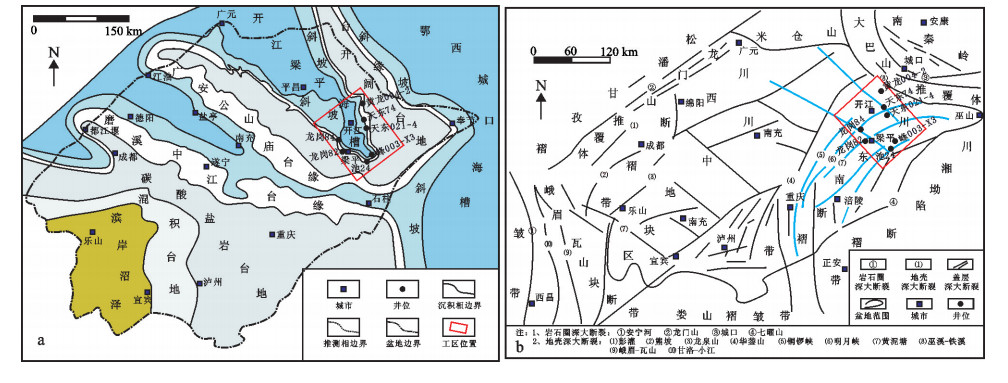
 下载:
下载:
